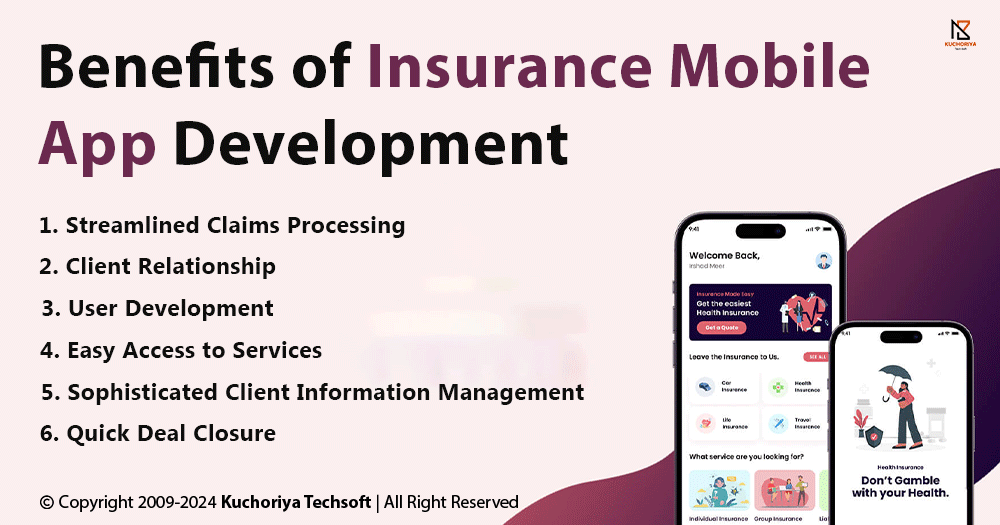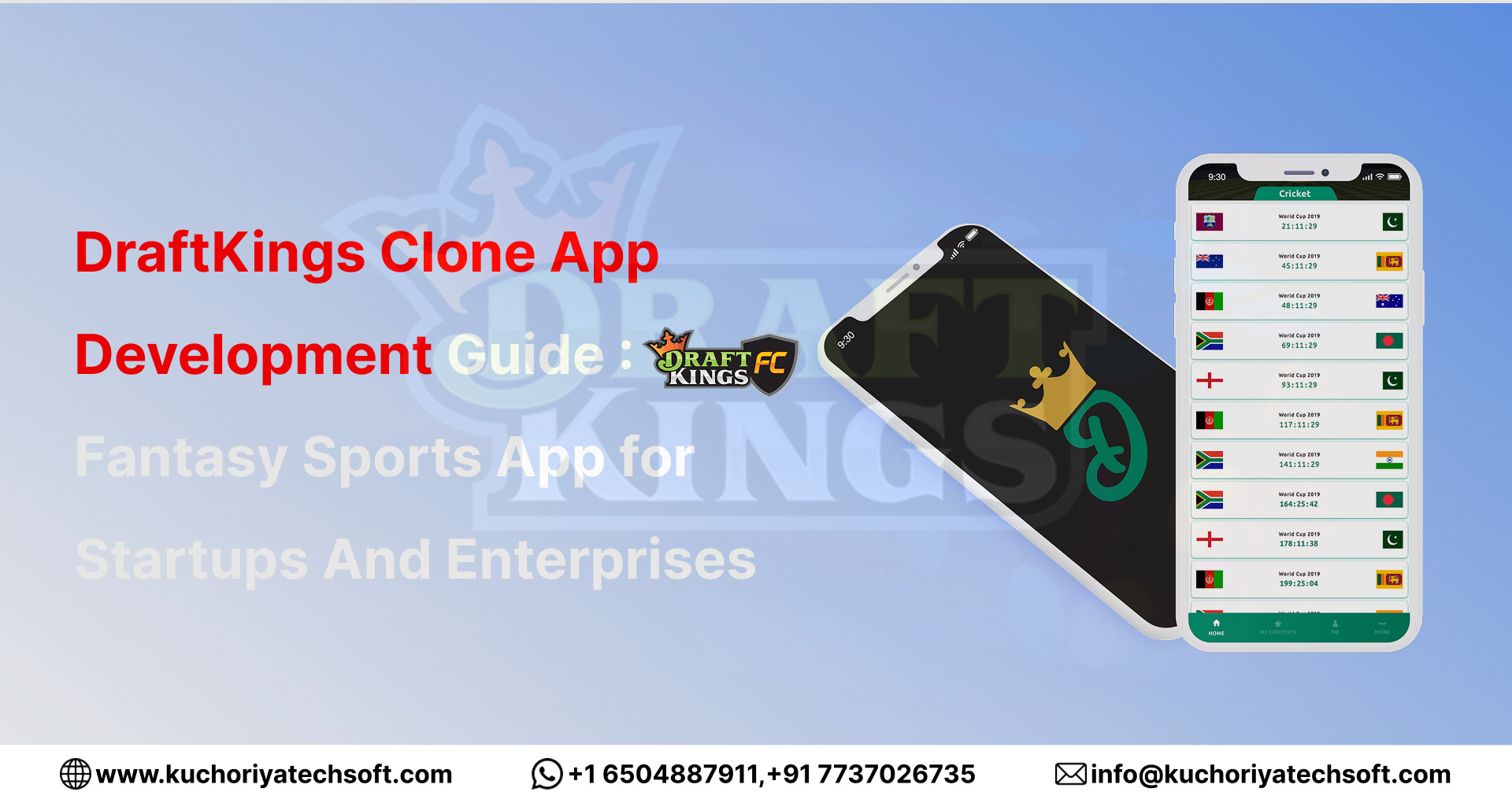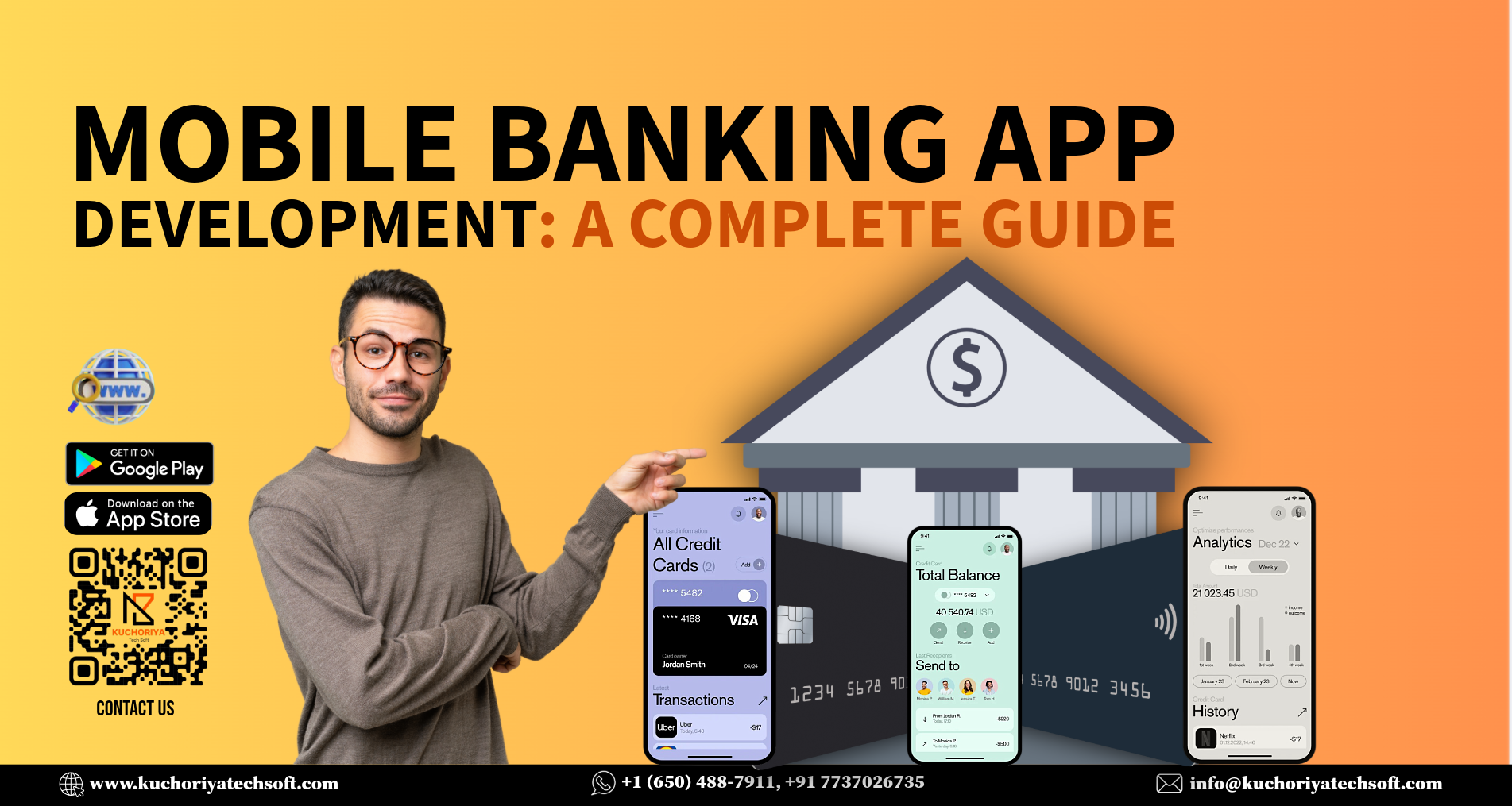Comprehensive Guide to Building an Insurance Mobile App: Essential Features, Benefits, and Costs
Insurance is important in our lives as it offers a safety net, shielding us from unforeseen financial responsibilities. Insurance provides peace of mind and financial security for our health, property, vehicles, and businesses when needed. Nevertheless, conventional insurance management practices can frequently become overwhelming and time-consuming, causing frustration and a feeling of being overwhelmed by many individuals. This is why there is such high demand for developing insurance mobile apps.
Insurance companies are moving towards developing mobile apps because of their increasing dependence on mobile technology. Through digital transformation, they can offer customers easy, on-the-go access to their insurance requirements.
At Kuchoriya Techsoft, our expertise lies in creating intuitive insurance applications that improve client satisfaction and operational efficiency. Through the use of our mobile app development experience, we assist insurance businesses in transforming their digital environments and guarantee safe, effective, and scalable solutions that meet their particular business requirements.
We'll present you with a step-by-step tutorial on creating your insurance mobile app in this blog. We can help you with everything from figuring out the key features to projecting development costs.
Let’s first explore,
Creating applications for smartphones and tablets that enable insurance businesses to communicate with clients and offer services is known as insurance mobile app development.
From their mobile devices, consumers can access insurance-related services, manage policies, file claims, get quotations, and make payments.
Now let's investigate.
Here’s a breakdown of its purpose:
- For insurance companies: Use a mobile platform to enhance client service, increase productivity, and possibly even expand into new markets.
- Policyholders may simply manage their insurance plans, process claims, obtain policy papers, and communicate with their insurers.
The insurance mobile app market is expanding quickly, especially in the US, where it is expected to increase at a 51.6% compound annual growth rate (CAGR) between 2023 and 2030. The desire for digital insurance solutions that facilitate simple access to services and improve consumer engagement through mobile devices is driving this increase.
By 2026, the insurance market is projected to grow to a size of $8.4 trillion globally. The mobile phone insurance market is growing considerably within this. Valued at $30.66 billion in 2023, it is projected to increase to $82.19 billion by 2031 at a compound annual growth rate (CAGR) of 13.12% beginning in 2024. The increasing use of mobile devices for routine chores, such as handling insurance policies and claims, is mostly to blame for this increase.
This growth is also largely being driven by the incorporation of cutting-edge technology like chatbots and artificial intelligence (AI) into mobile applications. By offering prompt support, individualized care, and streamlined procedures, these technologies improve customer interactions and greatly increase user pleasure and experience.
This growing trend makes it evident that creating mobile apps for insurance has several benefits, such as improved client engagement, increased operational efficiency, and a competitive advantage in the market. Insurance businesses that invest in mobile app development are well-positioned to take advantage of the expanding industry and satisfy the changing needs of their clients as the demand for these digital solutions only grows.
You would likely agree that creating a mobile app for insurance helps users simplify their interactions with the insurance company. Let's examine the primary problems that the customer insurance app can finally resolve.
1. The Omnichannel Gap: To establish a connection with prospective customers, insurance companies frequently use agents and brokers at important touchpoints. Nonetheless, they are unable to promote profitable growth and provide a customized experience. Creating an app gives insurance firms the most convenient way to connect with and interact with their tech-savvy clientele.
2. Inadequate Data Protection: It is important to protect sensitive insurance data. There is a chance that hackers could be able to obtain this data through conventional methods and techniques. Appointing a seasoned insurance app development company as a partner will guarantee appropriate data security. It would make it possible to reduce operational risks and prevent fraud and data leaks. Professional software developers use contemporary technologies to adhere to the most recent safety regulations. It would cover secure SSL connection protocols, biometric authentication, multi-factor authentication, and more.
3. Smooth Data Sharing and Access: The company's reputation suffers greatly if there is no backup plan and the insurance portal goes down. Your insurance app development partner can assist you with an operationally dependable platform to help you prevent such problems and guarantee continuous business continuity. Depending on your company's requirements, they can assist you in selecting between reputable cloud service providers like Microsoft Azure or Amazon Web Services.
4. Inaccurate Forecast: It might be difficult to manage and understand the massive amounts of data that insurance firms acquire from various sources. To convert the deluge of data into insights that can be put to use, policymakers require advanced analytics technologies. The collection, visualization, and analysis of data can be facilitated by the use of data analytics in conjunction with potent technologies like machine learning (ML) and the Internet of Things (IoT). For quick and efficient decision-making, it would allow precise forecasting and demand prediction.
5. Claims processing and underwriting are slow because manual insurance processes require a lot of paperwork that is prone to errors. The processing of claims and underwriting is hampered. With the help of insurance software, you can automate many common, repetitive tasks and provide accurate, timely, and efficient services.

The development of insurance mobile apps offers some strategic benefits that can have a significant impact on client engagement, operational effectiveness, and overall business success. Let us examine in more detail the main advantages of insurance applications:
1. Streamlined Claims Processing
The ability to streamline and expedite the claims process is one of the main advantages of developing mobile apps for insurance. Policyholders can file claims, upload required files (such as receipts or pictures), and monitor the status of their claims in real time. This enhances client satisfaction by lowering administrative hassles and increasing openness and efficiency in the claims process.
2. Client Relationship
With 85% of consumers conducting internet research before making purchases, consumers are becoming more frugal with their money these days. Insurance smartphone apps are essential since they provide immediate assistance when needed. Given that 63% of users feel at ease communicating with chatbots, policyholders choose to manage and track their policies through mobile apps. To identify the best benefits, they can also compare various insurance policies.
3. User Development
Providing outstanding customer service has the power to convert customers into influential brand ambassadors. An additional advantage of developing an insurance mobile app is the ability to draw in new customers through referral schemes. In addition to streamlining the customer acquisition process, this strategy enables insurance agents to focus on higher-value customers. Additionally, you can efficiently use targeted marketing to grow your consumer base by running ads across connected apps.
4. Easy Access to Services
The days of in-person visits and protracted documentation are long gone. Agents may carry out critical functions remotely with the help of insurance mobile app development, including processing policy applications and renewals and conducting client needs assessments. This ease of use enhances service accessibility and responsiveness while also saving time for both clients and agents.
5. Sophisticated Client Information Management
One important advantage of developing mobile apps for insurance is data management. Insurance companies can obtain significant insights into the behavior, preferences, and engagement patterns of their customers by utilizing the comprehensive analytics and reporting features of insurance mobile apps.
A comprehensive perspective of consumer interactions is provided by admin web panels, facilitating well-informed decision-making and customized service offers. With this data-driven strategy, insurers may satisfy client needs proactively and modify their plans in response to changing market conditions.
6. Quick Deal Closure
As the industry grows, client acquisition and retention depend increasingly on speed. During client meetings, insurance mobile app development gives agents rapid access to product information, premium calculators, and policy comparisons, which speeds up deal closes. Agility is a benefit of developing insurance mobile apps; it enhances the client experience and fortifies the insurer's competitive advantage.

1. Vehicle Insurance Apps
Apps for auto insurance are made to be accessible and convenient for owners of cars, motorcycles, and other types of vehicles. With the use of these apps, users may check policy data, pay premiums, and access digital policy documents, among other insurance policy management functions.
Additionally, they make it easier for customers to file insurance claims directly through the app, giving them access to real-time claim status updates and the opportunity to speak with adjusters or agents of insurance. To provide users with prompt assistance when needed, some apps go above and beyond by providing roadside assistance services like towing or emergency repairs.
2. Life Insurance Apps
Another category of insurance apps is life insurance, which aims to give users the resources they need to effectively manage their life insurance requirements. Through the app, users can simply apply for policies, browse various life insurance policy options, and calculate premiums based on personal information and coverage preferences.
These insurance applications frequently have health tracking tools that let users keep an eye on exercise goals or other health indicators that may affect insurance rates. To make sure that their preferences are appropriately reflected in their policies, policyholders can also manage beneficiaries using the app, updating beneficiary information as necessary.
3. Health Insurance Apps
A health insurance app is a different kind of insurance app that's made to make managing health insurance plans and associated services easier. These apps allow users to manage and monitor their health insurance policies, examine coverage details, and change personal data like preferred healthcare providers or contact details.
To assist customers in making educated selections while seeking medical attention, this kind of insurance mobile app development frequently includes directories of healthcare providers covered by the insurance plan, replete with ratings and reviews. These apps help expedite the claims procedure by giving customers the ability to monitor existing claims, file new ones, and retrieve digital insurance cards for simple verification at doctor's appointments.
4. Property Insurance Apps
Property insurance applications provide solutions to efficiently handle property insurance policies for owners of commercial and residential real estate as well as tenants. These apps allow users to access and manage their insurance plans, examine coverage details, and update personal data like preferred insurance agents or contact details.
In addition to giving users real-time updates on the status of their claims and enabling discussion with adjusters or insurance agents, they frequently come equipped with capabilities for filing insurance claims straight through the app. Additionally, some apps have features like property alarms that inform users of any dangers or weather conditions that can affect their property.
5. Travel Insurance App
Travel insurance applications are made to offer passengers comprehensive coverage and support because travel is becoming more and more popular. Through the app, users may buy travel insurance policies that are customized to their individual trip's parameters, such as duration and destinations.
6. Business Insurance App
Business insurance mobile applications allow entrepreneurs and businesses to effectively oversee their commercial insurance, such as liability, property, and workers' compensation. These applications protect large business investments by enabling policyholders to choose appropriate insurance packages that are customized based on their business size and risk profile. Customers can quickly buy insurance plans and promptly handle covered incidents, reducing potential damages. These apps make sure that businesses are safeguarded from major risks and able to stay stable when unexpected challenges arise by simplifying the insurance process and offering fast access to coverage options and claims handling.
Access to emergency support services, such as medical evacuation, hospital coordination, and help with misplaced passports or travel documents, is made possible by these kinds of insurance apps.
Through the app, travelers may handle and monitor claims for covered events like lost luggage, medical emergencies overseas, or canceled trips, guaranteeing a seamless and effective procedure even when on the road. Furthermore, travel warnings and destination-specific safety information are frequently included in travel insurance apps, guaranteeing that passengers are well-informed and ready for anything.
Now that we know the different types of insurance apps, let's look at the essential features you should build into your mobile insurance app.
A well-thought-out insurance mobile app may expedite processes and greatly enhance client experience. The following are the things that your insurance app ought to include at minimum:
1. Management of user-profiles and registration
Encouraging users begins with offering a simple registration process. Permit users to safely and swiftly create an account. After registering, individuals ought to have little trouble managing and storing their contact and personal data. The insurance app serves as a one-stop shop for all of the customers' insurance needs thanks to this functionality, which guarantees that users can access, update, and manage their policies straight from the app.
Example:
Applications such as Root for auto insurance streamline and expedite the registration process. In little time at all, users can register, create an account, and begin managing their accounts. After registering, users can examine their insurance policies, keep and update their contact and personal data, and make any necessary changes. The Root app is a comprehensive tool for handling all of a user's auto insurance needs directly because it also lets users check their driving score, which affects their price.
2. Administration of Policies
Making it simple for users to access their current insurance policies, check coverage details, and download policy paperwork is another crucial component of a well-developed insurance app. Users should also be able to set up automatic payments, pay premiums, and renew their policies all using the app. User loyalty and happiness can be significantly increased with this degree of convenience.
3. Policy Citations and Suggestions
One essential element of insurance apps is the ability to provide immediate rates for new policies. It should be possible for users to input their details and receive prices tailored to their requirements and preferences. Moreover, the insurance app can make tailored suggestions for insurance products based on user data, increasing the usefulness and relevance of the service.
4. Processing of claims
Nobody has the time for the traditional runaround. Improving the customer experience hinges on streamlining the claims process. When creating an insurance application, it is essential to enable users to file a claim, upload necessary paperwork, and monitor the progress of their claim instantly. Incorporating functions to smooth out the process of submitting and handling claims can greatly lessen the inconvenience and tension linked with insurance claims.
5. Integration of a payment gateway
Certainly, your insurance application must have a reliable payment gateway. Having a secure payment gateway in an insurance app is crucial for users to conveniently pay premiums and file claims through the app itself. Users can enjoy a convenient and flexible payment experience by having various payment options such as credit/debit cards, digital wallets, and net banking.
6. Alerts and notifications
Notifying users of significant events promptly is essential. Alerts for policy renewals, premium due dates, updates on the status of claims, and other important information should be sent by your insurance app. Furthermore, consumers may receive timely and pertinent information from location-based alerts for crises or natural disasters that may affect their insurance coverage.
7. Customer Support
To help consumers with their questions and concerns, in-app customer service channels like live chat, email, and phone support are crucial. By integrating chatbots or virtual assistants, consumers can obtain timely support whenever they need it by getting short, automated answers to frequently asked issues.
8. Document Upload and Storage
Let's finally discuss uploads and document management. One extremely useful aspect of the app is the ability for users to upload and retain pertinent documents, such as medical records, vehicle documentation, or property details. This guarantees that customers will have simple access to these documents for future reference or while processing claims, as well as safe storage for them.
Your insurance app will be prepared to offer a smooth, effective, and user-friendly experience if it has these qualities.
Bonus Read: Best Mobile App Development Company in the USA
Creating an insurance mobile app for your company necessitates detailed preparation and implementation. Below is a detailed walkthrough to assist you in navigating the process successfully:
1. Identify Your Target and Objectives: Establishing a precise goal for the creation of your insurance mobile app should come first. Knowing your objectives will direct the entire mobile app development process, regardless of whether it's policy management, claim processing, or increasing client interaction.
To customize your app's functionality and user experience, decide who your target audience is—individual customers or companies in the insurance sector.
2. Planning and Research: Start by studying current insurance apps in great detail. Examine their features, user reviews, and areas that require development. The definition of your application's primary features will be guided by this study. Afterward, draw out the user journey using wireframes or flowcharts to guarantee easy navigation and a smooth user experience through the program.
3. Select the Appropriate Technical Stack: Selecting the optimal technological stack is crucial for the creation of your insurance mobile application. Depending on your preferred platform, choose from native (iOS, Android), hybrid, or cross-platform mobile app development.
Choose a backend architecture that complies with the data storage, user authentication, and third-party integration needs of your insurance app.
Back End Tech Stack
- Server: Apache, Nginx, Microsoft IIS
- Hosting: AWS, Google Cloud, Microsoft Azure
- Storage: Amazon S3, Google Cloud Storage, Azure Storage
- Database: MySQL, PostgreSQL, MongoDB, Cassandra
- Payment Gateway: Stripe, PayPal, Braintree
- Other: Git, Jenkins, Docker, Kubernetes
Front End Tech Stack
- Android: Java, Kotlin, Android Studio, Android UI
- iOS: Objective-C, Swift, XCode, UIKit
- Cross-platform: React Native, Flutter
New Technologies
- Artificial Intelligence (AI) for risk assessment, fraud detection, and customized goods
- Internet of Things (IoT) for monitoring insured assets in real time by gathering data from connected devices
- Blockchain for smart contracts and safe, transparent data sharing
- To protect sensitive data, use cybersecurity techniques like cloud encryption, multi-factor authentication, and behavioral analytics.
The particular tech stack is determined by the type of insurance app (life, health, property, and so on), the target platform (native iOS/Android vs. cross-platform), and the financial and schedule constraints of the project. The security, scalability, and high performance of the insurance app are all dependent on the tech stack that is chosen.
4. Create User Experience (UX) and User Interface (UI): Next, concentrate on developing an interface that is easy to use, represents your brand identity, and appeals to your intended market. To increase usability, give priority to clear design and easy navigation. Make sure the user experience is flawless for every aspect of the app, from registering to filing claims.
5. Create and Examine Your App: Enter the development phase as soon as you have a strong design base. Implementing fundamental functions like user registration, policy administration, claims processing, and safe payment integration should come first. Here, testing is essential. Run comprehensive tests before launching your insurance app to identify and fix any bugs or usability problems.
6. Put Security Measures in Place: Ensuring data security ought to come first. To protect sensitive user information, such as payment details and personal records, use strong encryption measures and make sure you comply with any applicable legislation, like GDPR or HIPAA. Encouraging user confidence requires establishing trust via safe data handling practices.
7. Deploy and Launch: Learn about the requirements for app store submissions on sites such as the Apple App Store and Google Play Store as you get ready for deployment. Concurrently, design a marketing plan to efficiently endorse your application via platforms such as social media, content marketing, and strategic alliances.
8. Keep an eye on and update: After the app launches, you can track feature usage, user engagement, and app performance by integrating analytics tools. Prioritize updates based on user demands and industry trends after gathering user feedback to identify areas for improvement.
You can make sure that your insurance app offers genuine value by carefully following these steps, which can expedite the development process, boost customer satisfaction, and drive business growth.
Depending on complexity and features, the expenses associated with developing an insurance mobile app can vary greatly. These include:
- The Cost of Basic Insurance Mobile App Development: The price range for more basic apps with fewer features is usually between $15,000 and $50,000. Typically, these apps include basic policy administration and user registration, among other vital functions.
- The Cost of Complicated Insurance Development of Mobile Apps: Apps with a medium level of sophistication can cost somewhere between $50,000 and $100,000 and contain features like in-app chat, payment gateways, and personalized user interfaces. The functionality and user experience are enhanced by these additions.
- Cost of Developing an Advanced Insurance Mobile App: Development fees for apps with sophisticated capabilities, such as predictive analytics, business intelligence tools, and geolocation services, can range from $100,000 to $350,000. The insurance app's features provide consumers with cutting-edge functionality and data-driven insights.
At Kuchoriya Techsoft, our expertise lies in creating tailored solutions that align with the distinct possibilities and problems faced by the insurance industry.
You can hire mobile app developers from our team and industry experts who are skilled at integrating key features like AI-driven underwriting, blockchain for secure transactions, and IoT for telematics solutions. These professionals can work on anything from policy administration systems to claims management platforms and more.
Whether you're a startup trying to take the industry by storm or a traditional insurer trying to digitize your offerings, our all-encompassing strategy guarantees that your app stands out in the fintech mobile app development market.
Following is a list of mid-level insurance startups, together with the problems they faced, the remedies Kuchoriya Techsoft offered, and the status of their businesses following the implementation of those solutions:
Difficulties: Insurify had trouble with outdated technology for customer support, which caused delays in processing claims and unhappy customers.
Kuchoriya Techsoft's solutions included the integration of a customer self-service portal, the use of AI and machine learning to optimize the claim processing system, and the implementation of a custom chatbot for round-the-clock client help.
Impact and Results: Within six months, there was a 20% rise in customer satisfaction ratings, a 30% faster claim processing process, and a significant reduction in customer care response times.
Difficulties: The profitability and client retention were being negatively impacted by high operational costs and a laborious claims verification process.
Kuchoriya Techsoft's solutions include the development of a blockchain-based claims verification system that automates and secures the processing of claims while lowering fraud and human error. Additionally, cloud-based technologies were used to optimize backend operations and save costs.
Impact and Results: A notable improvement in client retention, a 15% reduction in operational costs, and a 40% reduction in claims processing time.
Difficulties: Oscar Health encountered difficulties in maintaining client data, which resulted in ineffective marketing campaigns and individualized service delivery.
Kuchoriya Techsoft as Solutions developed a consolidated platform for data management that combines AI and advanced analytics to provide customized services, forecasted insights, and focused marketing efforts.
Impact and Results: Enhanced data security compliance, increased client acquisition by 25%, and improved targeted marketing campaign efficiency by 35%.
Challenges: In order to increase customer engagement and grow its user base, Metromile needs to improve the user experience on its mobile app.
Kuchoriya Techsoft's solutions included a user-centric redesign of the mobile app with integrated features like real-time tracking, rapid quotations, and a smooth onboarding procedure. added a gamification component to boost user interaction.
Impact and Results: Customer satisfaction scores rose by 30%, app downloads jumped by 50%, and user engagement rose by 40%.
Challenges: Because of manual processing, Next Insurance had trouble effectively managing small company insurance coverage.
Kuchoriya Techsoft's solutions: AI-driven solutions, such as automated underwriting and renewal management, have automated the policy management process. presented a digital platform that is easy to use for owners of small businesses.
Impact and Results: Handle processing was 70% less, policy issuing took minutes instead of days, and overall operational efficiency was 50% higher.
Challenges: Trov's limited customer engagement features and scalability concerns contributed to a high turnover rate.
From Kuchoriya Techsoft: Solutions To manage the growing number of users, a scalable cloud architecture was constructed, and sophisticated customer interaction tools including loyalty programs, personalized offers, and real-time notifications were incorporated.
Impact and Results: Saw a 25% increase in active users, a 15% lower churn rate, and scalability to accommodate three times expansion.
With the aid of these Kuchoriya Techsoft solutions, the entrepreneurs were able to significantly expand in their respective industries, increase customer happiness, and improve operational efficiency.
Putting money into the creation of mobile apps for insurance is a wise decision that fits with the industry's expanding need for digital solutions. Having a strong insurance app may greatly improve customer engagement, streamline operations, and guarantee compliance with industry rules as mobile usage and customer expectations continue to climb.
Speak with our staff at Kuchoriya Techsoft if you need professional advice or are unsure of where to begin. Our industry experts are available to assist you in navigating the regulatory environment's intricacies, comprehending market trends, and creating a mobile application that not only satisfies user expectations but also meets industry requirements. Our primary goal is to develop solutions that will boost customer happiness, propel growth, and add real value for your company and its stakeholders.
Together, let's develop your idea into a killer mobile app that advances your company's objectives and keeps you ahead of the competition in a market that is always changing. To learn how we can help you take full advantage of this opportunity, get in touch with us right away.
The Referral Partner Program by Kuchoriya Techsoft provides a smooth method to generate continuous revenue in the long run. You can receive financial rewards by referring your contacts to us when you team up with us. Our program was created to be stress-free, enabling you to easily reap the rewards. Promote the exceptional services offered by a reputable software development company to see an increase in recommendations through our excellent eCommerce web development and custom blockchain app development services.
Furthermore, our Referral Partner Program helps to enhance the sales and entrepreneurial skills of your referrals over the long run. Through partnering with Kuchoriya Techsoft, your connections will have access to state-of-the-art technologies and skilled development teams that enhance their business operations. This relationship, which benefits both parties, enhances their success and cements your position as a critical factor in their expansion. Come and be a part of our team today to experience the benefits of earning money while also helping your network achieve long-term success.
Q. What are the main advantages of utilizing a mobile app for insurance?
A. An insurance mobile app facilitates the entire insurance experience by providing quick access to policy administration, expedited claims processing, and handy customer service.
Q. How much does creating a unique insurance mobile app often cost?
A. A custom insurance mobile app's development cost varies greatly depending on its features, complexity, and development team. Expenses typically vary from several thousand to more than a hundred thousand dollars.
Q. What characteristics ought a trustworthy insurance mobile application to have?
A. Features like policy administration, tracking and submission of claims, customer assistance, secure login, and real-time notifications are essential for a dependable insurance mobile app.
Q. How might an insurance app improve the effectiveness of the claims procedure?
A. By enabling users to file and follow claims through the app, an insurance app expedites the claims process, cutting down on paperwork and shortening the time it takes for a claim to be resolved.
Q. What are the most recent developments in the creation of mobile insurance apps?
A. The utilization of real-time data to boost operational effectiveness and user experience, improved security measures, and AI integration for tailored services are some of the current developments.
Q. How might AI enhance an insurance mobile app's functionality?
A. AI improves insurance apps through data analysis to better user experience, chatbots for automated customer care, and personalized recommendations.
Q. What difficulties are frequently encountered while creating a mobile app for insurance?
A. Ensuring data security, integrating the app with current systems, and maintaining regulatory compliance while providing a user-friendly experience are common issues.
Q. What actions are required to make an insurance mobile app successful?
A. It takes precise goal-setting, user-friendly design, feature integration, extensive testing, and a solid launch plan to create a successful insurance mobile app.
Q. How can an insurance mobile app benefit from real-time analytics?
A. Real-time analytics give information about how users behave and how well apps function, enabling prompt adjustments and enhancements that raise user satisfaction levels all around.
Q. What makes data security in a mobile insurance app important?
A. Ensuring data security is imperative in safeguarding confidential user information, according to regulatory requirements and upholding user confidence in the insurance provider.
HIRE A TOP SOFTWARE DEVELOPMENT COMPANY
We are all over the world
United State
9765 keystone court, Clarence, NY 14031 , USA, +1 (650) 488-7911
Canada
1100 Caven St., Suite PH11, Mississauga, ON L5G 4N3 Canada , +1 (416) 726-4662, +1 (650) 488-7911
Brazil
Bispo César da Corso Filho, 1266, San Carlos, São Paulo, Boa Vista, Brazil, 13575-331
South Africa
12 IbisWay, Sunnydale Fish Hoek 7985 Western Cape, South Africa, +27824507091
Spain
The Fir Tree 119 El Olmillo Residential Area Loranca de Tajuña 19141 Guadalajara, Spain
UAE
Building A2 DDP - Dubai Silicon Oasis - Dubai - United Arab Emirates
Italy
Viale dell'Esperanto, 71, Formia, Italy, Lazio IT
Singapore
01-08 50 Ubi Cres, Ubi TechPark, Singapore, 408568
Hong Kong
Tower 2, Silvercord, Rm 907, 9F, 30 Canton Rd, Tsim Sha Tsui, Hong Kong
Australia
Unit 14G, 3 darling point road, darling point, Sydney, NSW, Australia, 2027
India
C-15, 1st floor, Mahalaxmi Marg, Behind World Trade Park, Malviya Nagar, Jaipur, Rajasthan - 302017



















